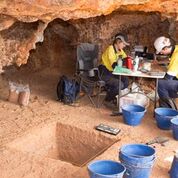A team of international archaeologists say evidence from a remote cave in Australia’s North West pushes back human occupation of Australia to around 50,000 years ago.
The discovery, by a team that included a University of Queensland researcher, is of international significance in providing the earliest direct dates for Aboriginal use of marine resources in Australia.
Lead archaeologist Professor Peter Veth, from The University of Western Australia, said the findings provided unique evidence for the early and successful adaptation of Aboriginal people to both coastal and desert landscapes of Australia.
“This site contains cultural materials clearly associated with dates in the order of 50,000 years,” Professor Veth said.
“This pushes back the age of occupation from the previous and more conservative limit of 47,000 years ago. Even older dates are entirely plausible.”
The team which included UQ archaeologist Dr Tiina Manne, focused on Barrow Island, a large limestone island located 60 km off the Pilbara coast of Western Australia.
Dr Manne, a specialist in the analysis of animal remains from archaeological sites said the antiquity of this site coupled with its exceptionally well-preserved bone and shell is unknown from other sites in northern Australia.
“Most archaeological sites in the north do not have food remains as they just don’t survive in harsh, tropical conditions.
“The animal remains from Barrow Island provided us with an incredible archive of local environmental change over a very long period of time, along with profound insights into how people adapted and responded to a new and ever-changing arid landscape,” Dr Manne said.
The research, published in Quaternary Science Reviews, was led by UWA and funded as a Discovery Project by the Australian Research Council. It was undertaken with the participation and support of the Buurabalayji Thalanyji Aboriginal Corporation and Kuruma Marthudunera Aboriginal Corporation and included researchers from James Cook University, The University of Waikato, The University of Adelaide, Sacramento State University, Curtin University, Oxford University and the WA Department of Parks and Wildlife.
The researchers worked with four international dating laboratories to rigorously date deposits in Barrow Island’s Boodie Cave. Professor Veth said the location provided the longest sequence of dietary remains from any Australian site.
 “The cave was used predominately as a hunting shelter between about 50,000 and 30,000 years ago before becoming a residential base for family groups after 10,000 years ago. It was abandoned by about 7000 years ago when rising sea levels finally cut it off from the mainland,” he said.
“The cave was used predominately as a hunting shelter between about 50,000 and 30,000 years ago before becoming a residential base for family groups after 10,000 years ago. It was abandoned by about 7000 years ago when rising sea levels finally cut it off from the mainland,” he said.
“Our current research at Barrow Island has provided the earliest evidence of coastal living in Australia. Remarkably the early colonists of the now-submerged North West Shelf did not turn their back on the sea or remain coastally tethered but rapidly adapted to the new marsupial animals and arid zone plants of the extensive maritime deserts of North West Australia.”
Media: Dr Tiina Manne, t.manne@uq.edu.au, +61 7 336 51212, 0400 537 915; Professor Peter Veth, peter.veth@uwa.edu.au, +61 8 6488 1807, 0408 094 607
For video and images CLICK HERE.
.jpg)












